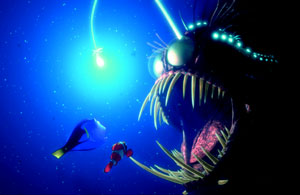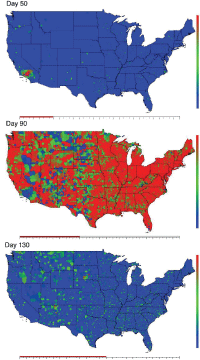
Flaubert’s Barometer and Simulation as Evidence

Illustration 1: Finding Nemo,
copyright Pixar and Walt Disney Studio
In one of Roland Barthes’ most famous essays, “The Reality Effect,” he speaks of the real as an effect of peculiar details:
“Flaubert’s barometer, Michelet’s little door finally say nothing but this: we are the real; it is the category of ‘the real’ (and not its contingent contents) which is then signified.”
But what then happens to the category of “the real” when it is anchored in simulation?
The question might well seem suited for a Jean Baudrillard to answer. But our Townsend Center G.R.O.U.P. course has set us instead along into an exploration of procedural animations, simulations, and their effects.
Computer graphics simulations—constructions of visual models to show complex particle dynamics including weather, explosions, plebiscites, and epidemics—have become a powerful communication device as our desire to see dynamic processes and their outcomes from all angles increases. Used pervasively in arenas as diverse as entertainment to policy debates, these simulations so accurately mimic real dynamic processes, and offer the advantage of arbitrary timescales and points of view, that we increasingly admit them into the theaters of our minds as evidence of reality itself.
For example, the feature animation Finding Nemo (Illustration 1) shows a clownfish named Marlin in search of his only child, Nemo, who was abducted by a poacher. In his search, Marlin braves many adventures, including an encounter with an Angler fish prowling the bottom of the ocean, looking for a meal. In the animation, the water, of course, does not exist, and Marlin, his friend, Dory, and the Angler exist only as groups of triangles moving in a mathematical space, reflecting mathematical beams of light into a mathematical camera. Yet the scene strikes terror into the hearts of many viewers, as the drama of innocence in the face of real-world dangers unfolds and the need for responsible action surges.
Mathematical the characters may be, but the drama feels real. It feels real partly because of excellent storytelling and great actors who lend their characters human voices, but also because of expressive motion, and because of the silt simulation; as the Angler darts after Marlin and Dory, it stirs up vortices of silt, which only slowly settle into the darkness of the ocean ground, after the fish passes. The computer graphics simulation of the swirling silt connects us as viewers to our hero’s suffering, because we know how silt swirls, and it swirls just like the simulation in the movie.
Looking at the process of computer graphics simulation, we can gain more insight into why the simulation so compellingly references the real. For the silt simulation, Apurva Shah, a technical director (TD) at Pixar, wrote a computer program to randomly distribute a group of particles on the three-dimensional topography of the mathematical ocean floor. Dr. Shah then defined several force fields to affect these particles, including a gravity field, a drag field, and a turbulence field. For this scene, about 10 million particles were in motion. Shah constrained the turbulence field to the Angler fish, so that the turbulence would affect silt particles in proximity to the Angler only. A random noise factor in the turbulence caused each particle to move in a distinct fashion similar to Brownian motion. The turbulence decreased proportionately to the distance from the Angler, so its effect increased the closer the Angler got to the particles on the ground, and subsided once the Angler moved away. The drag field and the gravity field dampened the motion of the stirred-up particles, and caused the particles to eventually settle on the ocean ground again.
Since this simulation was based on approximations of Newton’s Law of Motion, it adhered to principles of the natural order. Given the medium of water, the typical weight of silt, as well as the wake of a passing fish, the silt simulation was a realistic approximation of what might really be going on in the ocean floor. The Angler fish was fake, the ocean floor was fake, but the motion of the silt in response to the fake fish was an accurate model of fluid dynamics such as we encounter in the physical world. The silt simulation marks the real relation between fish and water, although neither water nor fish are real. It functions as an indicator of reality, much like Flauberts’ barometer in Barthes’ essay.
Neither a character, nor a story element, the silt is not conveying anything but the category of “the real.” It operates in two ways: it articulates a relation between fish-figure and ocean-ground and delivers material evidence for an artificial physical reality, and it produces a temporal cause and effect, a historical trace of the existence of a character that never lived.
The simulation is materially correct, although none of the elements involved in the simulations are real. This is because the simulation follows the same laws as that which it simulates. Comparing our viewing experience with our mental models of physics, we willingly ascertain that something real is going on. The mere fact that a simulation employs the same laws that affect our lived, material reality, aids our suspension of disbelief and allows us to accept strong violations of realism—such as talking fish—and “sells the shot.” Moreover, because the simulation so precisely registers with previous physical experiences of similar phenomena, it seems to increase our ability to empathize with the character, as we wonder how difficult it must be to live among all the muck in the bottom of the ocean. The simulation brings our own body into the picture.
The silt motion simulation differs from traditional animation in that it is a direct result of real time passing, not an arbitrary state. In traditional animation, an object occupies its position explicitly in each key frame. The fish is in a specific place at a specific time, independently of any other positions at any other times. In a simulation, however, the position at time B depends on the velocity of the particle and its position at a previous time A. Each time a TD like Dr. Shah runs the silt simulation, the results differ in the details—each particle encounters a different fate. The process of computing the positions of each particle is substantially slower than the duration of the scene, which means that a huge real temporal effort sustains a brief temporal illusion. In this temporal sense, a simulation is much closer to reality than an animation. As the fish stirs the silt up, it inscribes its existence into a historical, physical, and causal context we can connect to through our own physical experience. The silt simulation provides an experiential continuum between the artificial life of the screen fish and our own lives.

Illustration 2: Avian Flu Simulation,
reprinted with permission of
Los Alamos National Lab
While simulations serve as evidence of reality in entertainment, many other simulations we rely on to better understand our lived reality seem to excuse us of our real-life responsibilities. Climate simulations illustrate the effect of car culture on climate change, but do not lead to cultural change. Simulations of Hurricane Katrina did not inspire effective disaster relief plans in New Orleans. Los Alamos Labs has presented a flu pandemic simulation that models the spread of Avian Flu across the nation in 86 days, which does not seem to inspire immediate health-care policy changes.
The simulation technique that physically grounds us in entertainment via Reality Effect addresses us as individuals, with our own toes in the silt. The same simulation technique, which models disasters, however, does not connect dramatically, and does not ground us physically in disaster scenarios. Disaster simulations fail to reach us because they address us as a particle mass without moral choices and without sentient bodies. In the disaster simulation, we are the silt, the tiny particles, subject to forces far greater than us, tossed about by algorithms and metaphorical Angler fish monsters.
In the Los Alamos Avian Flu simulation (Illustration 2) we see the continental U.S. from a bird’s-eye perspective, which already precludes any individual experience, mediated or otherwise. In the simulation, a deadly virus spreads from Los Angeles to the rest of the continental United States. The disease vector is mainly travel. Blue areas are not affected by the disease, green areas show less than 100 infections, and red areas show more than 100 infections.
Here, the simulation achieves the opposite of the Reality Effect: the Delusion Effect. Because we see ourselves as one of many, we delude ourselves feeling that we certainly will be members of one of the “green,” “blue,” or spared areas, and certainly not one of those “red” areas. We also may excuse ourselves from those who helped initiate the disaster because we did not go to the doctor for lack of health insurance, or because we ignored a travel advisory. Perhaps this simulation would be more effective if it were framed from an individual perspective, perhaps like Camus framed The Plague.
Likewise, in the face of climate change simulations, we tend to excuse ourselves from contributing to the problem individually because such simulations tend to address collective situations.
Simulations serve as evidence of “the real” as a category if they address the experience of the individual body, but serve as a source of delusion if they deny the experience of the individual, sentient body. This leads to a basic paradox: if the simulation performs in a fictional context, we perceive it as a Reality Effect, but if it performs in a real-life context, we excuse ourselves from its claims to authenticity.
Greg Niemeyer (Assistant Professor of Art Practice) and Dan Garcia (Lecturer SOE in EECS) co-taught a GROUP course on procedural animations and simulations in Fall 2006.
This article can be found in the February 2007 newsletter.